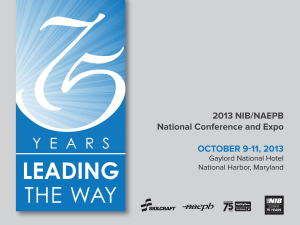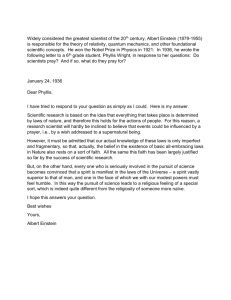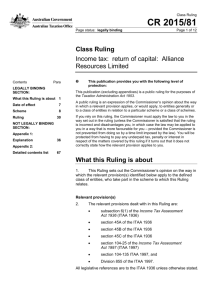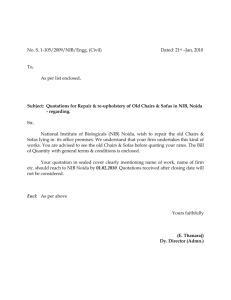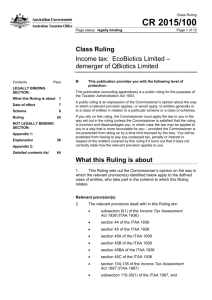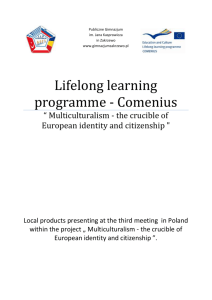View
advertisement
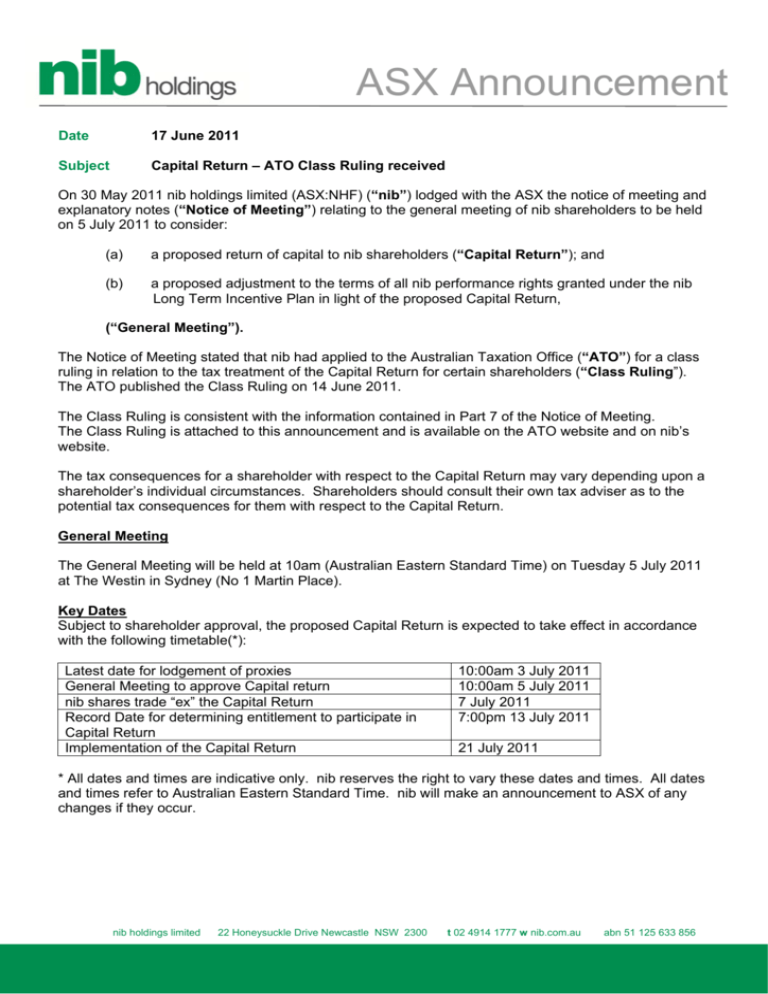
ASX Announcement Date 17 June 2011 Subject Capital Return – ATO Class Ruling received On 30 May 2011 nib holdings limited (ASX:NHF) (“nib”) lodged with the ASX the notice of meeting and explanatory notes (“Notice of Meeting”) relating to the general meeting of nib shareholders to be held on 5 July 2011 to consider: (a) a proposed return of capital to nib shareholders (“Capital Return”); and (b) a proposed adjustment to the terms of all nib performance rights granted under the nib Long Term Incentive Plan in light of the proposed Capital Return, (“General Meeting”). The Notice of Meeting stated that nib had applied to the Australian Taxation Office (“ATO”) for a class ruling in relation to the tax treatment of the Capital Return for certain shareholders (“Class Ruling”). The ATO published the Class Ruling on 14 June 2011. The Class Ruling is consistent with the information contained in Part 7 of the Notice of Meeting. The Class Ruling is attached to this announcement and is available on the ATO website and on nib’s website. The tax consequences for a shareholder with respect to the Capital Return may vary depending upon a shareholder’s individual circumstances. Shareholders should consult their own tax adviser as to the potential tax consequences for them with respect to the Capital Return. General Meeting The General Meeting will be held at 10am (Australian Eastern Standard Time) on Tuesday 5 July 2011 at The Westin in Sydney (No 1 Martin Place). Key Dates Subject to shareholder approval, the proposed Capital Return is expected to take effect in accordance with the following timetable(*): Latest date for lodgement of proxies General Meeting to approve Capital return nib shares trade “ex” the Capital Return Record Date for determining entitlement to participate in Capital Return Implementation of the Capital Return 10:00am 3 July 2011 10:00am 5 July 2011 7 July 2011 7:00pm 13 July 2011 21 July 2011 * All dates and times are indicative only. nib reserves the right to vary these dates and times. All dates and times refer to Australian Eastern Standard Time. nib will make an announcement to ASX of any changes if they occur. nib holdings limited 22 Honeysuckle Drive Newcastle NSW 2300 t 02 4914 1777 w nib.com.au abn 51 125 633 856 Class Ruling CR 2011/56 Page status: legally binding Page 1 of 14 Class Ruling Income tax: return of capital – nib holdings limited Contents LEGALLY BINDING SECTION: What this Ruling is about 1 Date of effect 8 Scheme 9 Ruling 20 NOT LEGALLY BINDING SECTION: Appendix 1: Explanation 26 Appendix 2: Detailed contents list This publication provides you with the following level of protection: Para This publication (excluding appendixes) is a public ruling for the purposes of the Taxation Administration Act 1953. A public ruling is an expression of the Commissioner’s opinion about the way in which a relevant provision applies, or would apply, to entities generally or to a class of entities in relation to a particular scheme or a class of schemes. If you rely on this ruling, the Commissioner must apply the law to you in the way set out in the ruling (unless the Commissioner is satisfied that the ruling is incorrect and disadvantages you, in which case the law may be applied to you in a way that is more favourable for you – provided the Commissioner is not prevented from doing so by a time limit imposed by the law). You will be protected from having to pay any underpaid tax, penalty or interest in respect of the matters covered by this ruling if it turns out that it does not correctly state how the relevant provision applies to you. 69 What this Ruling is about 1. This Ruling sets out the Commissioner’s opinion on the way in which the relevant provision(s) identified below apply to the defined class of entities, who take part in the scheme to which this Ruling relates. Relevant provision(s) 2. The relevant provisions dealt with in this Ruling are: • subsection 6(1) of the Income tax Assessment Act 1936 (ITAA 1936); • section 45A of the ITAA 1936; • section 45B of the ITAA 1936; • section 45C of the ITAA 1936; • section 104-25 of the Income Tax Assessment Act 1997 (ITAA 1997); • section 104-135 of the ITAA 1997; • section 855-10 of the ITAA 1997; and • section 855-15 of the ITAA 1997. Class Ruling CR 2011/56 Page 2 of 14 Page status: legally binding All subsequent legislative references in this Ruling are to the ITAA 1997 unless otherwise indicated. Class of entities 3. The class of entities to which this Ruling applies are shareholders of nib holdings limited (nib) who: (a) are registered on the nib share register on the Record Date for the return of capital, being the date for determining entitlements under the return of capital; (b) hold their shares in nib on capital account; and (c) are not subject to the taxation of financial arrangements rules in Division 230 in relation to gains and losses on their nib shares. (Note – Division 230 will generally not apply to individuals, unless they have made an election for it to apply to them.) Qualifications 4. The Commissioner makes this Ruling based on the precise scheme identified in this Ruling. 5. The class of entities defined in this Ruling may rely on its contents provided the scheme actually carried out is carried out in accordance with the scheme described in paragraphs 9 to 19 of this Ruling. 6. If the scheme actually carried out is materially different from the scheme that is described in this Ruling, then: • this Ruling has no binding effect on the Commissioner because the scheme entered into is not the scheme on which the Commissioner has ruled; and • this Ruling may be withdrawn or modified. 7. This work is copyright. Apart from any use as permitted under the Copyright Act 1968, no part may be reproduced by any process without prior written permission from the Commonwealth. Requests and inquiries concerning reproduction and rights should be addressed to: Commonwealth Copyright Administration Copyright Law Branch Attorney-General’s Department National Circuit Barton ACT 2600 or posted at: http://www.ag.gov.au/cca Class Ruling CR 2011/56 Page status: legally binding Page 3 of 14 Date of effect 8. This Ruling applies from 1 July 2011 to 30 June 2012. The Ruling continues to apply after 30 June 2012 to all entities within the specified class who entered into the specified Scheme during the term of the Ruling. However, this Ruling will not apply to taxpayers to the extent that it conflicts with the terms of a settlement of a dispute agreed to before the date of issue of this Ruling (see paragraphs 75 and 76 of Taxation Ruling TR 2006/10). Scheme 9. The following description of the scheme is based on information provided by the applicant. The following documents, or relevant parts of them, form part of the description of the scheme: • class ruling application dated 21 March 2011; and • further correspondence from the applicant dated from 24 March to 31 May 2011. Note: certain information has been provided on a commercial-inconfidence basis and will not be disclosed or released under Freedom of Information legislation. 10. nib, a company listed on the Australian Securities Exchange, proposes to make a return of capital to the shareholders in July 2011. nib is the head company of a consolidated group and only has ordinary shares on issue. Demutualisation 11. nib Health Funds Limited (nib Health) was demutualised in October 2007. nib Health was converted from a company limited by guarantee to a company limited by shares at the time of demutualisation. 12. The demutualisation resulted in a new corporate structure under which nib policyholders were ultimately issued with shares in nib, and nib in turn held all of the shares in the main operative entity, nib Health. The shares that were issued to the nib policyholders were consideration for the termination of their rights over the ‘mutual surplus’ of nib Health. 13. The amounts which stand to the credit of nib’s share capital account are referable to the mutual surplus of nib Health just prior to demutualisation. 14. The demutualisation was one to which Division 315 applied. Class Ruling CR 2011/56 Page 4 of 14 Page status: legally binding Return of capital 15. On 21 February 2011, nib announced that it planned to make a return of capital to its shareholders. 16. The return of capital represents capital in excess of nib’s capital and operating requirements. 17. Subject to shareholder approval the return of capital will be undertaken on the following terms: (a) pro rata to all shareholders based on the number of shares they hold on the Record Date; (b) the amount of the return of capital will be $0.1607 per share, or approximately $75 million in aggregate; and (c) the return of capital will be paid on the Payment Date entirely from nib’s share capital account – that is, the return of capital will be recorded in nib’s stand alone accounts by debiting approximately $75 million to nib’s share capital account. Other aspects 18. nib has a history of paying regular fully franked dividends. nib’s dividend policy will not change as a result of the return of capital. 19. This Ruling is made on the basis that: • a nib share is not an ‘indirect Australian real property interest’ as defined in section 855-25; • a nib shareholder’s right to the payment of the return of capital is not an ‘indirect Australian real property interest’ as defined in section 855-25; and • the share capital account of nib is not tainted. Ruling Distribution is not a dividend 20. The return of capital to nib shareholders will not be a dividend as defined in subsection 6(1) of the ITAA 1936. 21. The Commissioner will not make a determination under subsection 45A(2) of the ITAA 1936 or subsection 45B(3) of the ITAA 1936 that section 45C of the ITAA 1936 applies to treat all or any part of the return of capital as a dividend for income tax purposes. Class Ruling CR 2011/56 Page status: legally binding Page 5 of 14 Capital gains tax consequences 22. CGT event G1 (section 104-135) will happen when nib pays the return of capital to a nib shareholder in respect of a nib share that they own at the Record Date and continue to own at the Payment Date. 23. CGT event C2 (section 104-25) will happen when nib pays the return of capital to a nib shareholder in respect of a nib share that they own at the Record Date but cease to own before the Payment Date. Foreign resident shareholders 24. A nib shareholder who is a foreign resident, or the trustee of a foreign trust for CGT purposes, and who is paid the return of capital, disregards any capital gain made when CGT event G1 happens to their nib share if their nib share is not ‘taxable Australian property’ (sections 855-10 and 855-15). 25. A foreign resident, or the trustee of a foreign trust for CGT purposes, who is paid the return of capital and who owns a nib share at the Record Date but not at the Payment Date, disregards any capital gain made when CGT event C2 happens to their right to receive the return of capital if their right to receive the return of capital is not ‘taxable Australian property’ (sections 855-10 and 855-15). Commissioner of Taxation 15 June 2011 Class Ruling CR 2011/56 Page 6 of 14 Page status: not legally binding Appendix 1 – Explanation This Appendix is provided as information to help you understand how the Commissioner’s view has been reached. It does not form part of the binding public ruling. Distribution is not a dividend 26. Subsection 44(1) of the ITAA 1936 includes in a shareholder’s assessable income any dividends, as defined in subsection 6(1) of the ITAA 1936, paid to the shareholders out of profits derived by the company from any source (if the shareholder is a resident of Australia) and from an Australian source (if the shareholder is a nonresident of Australia). 27. The term ‘dividend’ in subsection 6(1) of the ITAA 1936 includes any distribution made by a company to any of its shareholders. However, paragraph (d) in the definition of ‘dividend’ excludes a distribution from the meaning of ‘dividend’ if the amount of a distribution is debited against an amount standing to the credit of the company’s ‘share capital account’. 28. ‘Share capital account’ is defined in section 975-300 as an account which the company keeps of its share capital, or any other account created on or after 1 July 1998 where the first amount credited to the account was an amount of share capital. 29. Subsection 975-300(3) states that an account is not a share capital account if it is tainted. Subsections 197-5(1) and 197-50(1) provide that a company’s share capital account may become tainted if an amount is transferred to it from any of the company’s other accounts. 30. The Commissioner makes this ruling on the basis that nib’s share capital account is not tainted. The amount that was credited to the share capital account of nib represented the mutual surplus that existed prior to demutualisation. 31. The return of capital will be debited to the share capital account. 32. Therefore, the return of capital will not constitute a dividend because of the exclusion for a debit to the share capital account in the definition of a dividend in section 6(1) of the ITAA 1936. Anti-avoidance provisions 33. Sections 45A and 45B of the ITAA 1936 are two antiavoidance provisions which, if they apply, allow the Commissioner to determine that all or part of a distribution is treated as an unfrankable dividend that is paid by the company out of profits to the shareholder. Class Ruling CR 2011/56 Page status: not legally binding Page 7 of 14 Section 45A – streaming of dividends and capital benefits 34. Section 45A of the ITAA 1936 applies in circumstances where capital benefits are streamed to certain shareholders who derive a greater benefit from the receipt of capital (the advantaged shareholders) and it is reasonable to assume that the other shareholders (the disadvantaged shareholders) have received or will receive dividends. 35. nib will provide its shareholders with a ‘capital benefit’ (as defined in paragraph 45A(3)(b) of the ITAA 1936) as the return of capital will be a distribution by nib to shareholders and will be paid from nib’s share capital account. 36. The capital benefit will be provided to all nib shareholders in direct proportion to their individual shareholding. As all shareholders benefit equally from the return of capital there is no ‘streaming’ of capital benefits to some shareholders while not to others. 37. Accordingly, section 45A of the ITAA 1936 will not apply to the return of capital and the Commissioner will not make a determination under subsection 45A(2) of the ITAA 1936 that section 45C of the ITAA 1936 applies in relation to the return of capital to the shareholders of nib. Section 45B – schemes to provide capital benefits in substitution for dividends 38. Section 45B of the ITAA 1936 applies where certain payments are made to shareholders in substitution of dividends. Subsection 45B(2) of the ITAA 1936 sets out the conditions under which the Commissioner may make a determination under subsection 45B(3) of the ITAA 1936 that section 45C of the ITAA 1936 applies. These conditions are that: 39. • there is a scheme under which a person is provided with a capital benefit by a company (paragraph 45B(2)(a) of the ITAA 1936); • under the scheme, a taxpayer (the relevant taxpayer), who may or may not be the person provided with the capital benefit, obtains a tax benefit (paragraph 45B(2)(b) of the ITAA 1936); and • having regard to the relevant circumstances of the scheme, it would be concluded that the person, or one of the persons, who entered into or carried out the scheme or any part of the scheme did so for a purpose (whether or not the dominant purpose but not including an incidental purpose) of enabling the relevant taxpayer to obtain a tax benefit (paragraph 45B(2)(c) of the ITAA 1936). Each of these conditions is considered below. Class Ruling CR 2011/56 Page 8 of 14 Page status: not legally binding A scheme 40. A ‘scheme’ for the purposes of section 45B of the ITAA 1936 is taken to have the same meaning as provided in subsection 177A(1) of Part IVA of the ITAA 1936. That definition is widely drawn and includes any agreement, arrangement, understanding, promise, undertaking, scheme, plan or proposal. 41. The return of capital will constitute a scheme for the purposes of paragraph 45B(2)(a) of the ITAA 1936 because the return of capital will provide shareholders with a capital benefit. A tax benefit 42. A taxpayer ‘obtains a tax benefit’, as defined in subsection 45B(9) of the ITAA 1936, if: • the amount of tax payable; or • any other amount payable under the ITAA 1936 or the ITAA 1997, would, apart from the operation of section 45B of the ITAA 1936: • be less than the amount that would have been payable; or • be payable at a later time than it would have been payable, if the capital benefit had instead been a dividend. 43. Ordinarily, a return of capital would be subject to the CGT provisions of the income tax law. Unless the amount of the return of capital exceeds the cost base of the shares, there will only be a cost base reduction under CGT event G1 (section 104-135). It is only to the extent (if any) that the return of capital exceeds the cost base of the shares that a capital gain arises. 44. A capital gain may not arise at all for certain foreign resident shareholders. By contrast, a dividend would generally be included in the assessable income of a resident shareholder or, in the case of a foreign resident, be subject to dividend withholding tax under section 128B of the ITAA 1936. Therefore, nib shareholders will obtain tax benefits from the return of capital. Relevant circumstances 45. Under paragraph 45B(2)(c) of the ITAA 1936, the Commissioner is required to consider the ‘relevant circumstances’ set out under subsection 45B(8) of the ITAA 1936 to determine whether any part of the scheme would be entered into for a purpose, other than an incidental purpose, of enabling a relevant taxpayer to obtain a tax benefit. However, the list of relevant circumstances in subsection 45B(8) is not exhaustive and regard may be had to other circumstances on the basis of their relevance. Class Ruling CR 2011/56 Page status: not legally binding Page 9 of 14 46. The test of purpose is an objective one. The question is whether it would be concluded that a person who entered into or carried out the scheme did so for the purpose of obtaining a tax benefit for the relevant taxpayer. This requisite purpose does not have to be the most influential or prevailing purpose but it must be more than an incidental purpose. 47. The purpose which causes section 45B of the ITAA 1936 to apply may be the purpose of any party to the scheme. In this case, however, the Commissioner is only concerned with the purpose of nib. The Commissioner cannot at this stage ascertain the purposes of nib’s numerous shareholders who are eligible to vote on the return of capital under section 256C of the Corporations Act 2001 and all of whom will participate in the return of capital. Nevertheless, in a case such as this, an objective conclusion as to the purpose of the company should, generally speaking, not be inconsistent with an objective conclusion as to the purpose of the shareholders, in particular those shareholders who will vote in favour of the proposal. 48. The relevant circumstances under subsection 45B(8) of the ITAA 1936 cover the circumstances of the company and the tax profile of the shareholders. In this instance, because the return of capital will be made to all nib shareholders holding ordinary shares, regardless of individual circumstances paragraphs 45B(8)(c) to 45B(8)(h) of the ITAA 1936 do not incline towards, or against, a conclusion as to purpose. The relevant matters are those covered by the circumstances described in paragraphs 45B(8)(a), 45B(8)(b) and 45B(8)(k) of the ITAA 1936. 49. Paragraph 45B(8)(a) of the ITAA 1936 refers to the extent to which the capital benefit is attributable to capital and profits (realised or unrealised) of the company or an associate (within the meaning of section 318 of the ITAA 1936) of the company. The capital amounts comprising the return of capital have been determined by nib to be excess to nib’s operating and capital requirements. The source of the return of capital is the mutual surplus of nib which is of a capital nature. 50. Paragraph 45B(8)(b) of the ITAA 1936 refers to the pattern of distributions made by a company or an associate (within the meaning of section 318 of the ITAA 1936) of the company. nib has a consistent history of making regular fully franked dividend distributions and expects this dividend distribution policy to continue. Accordingly, nib’s pattern of distributions does not suggest that the return of capital will be made in substitution for a dividend. 51. Paragraph 45B(8)(k) of the ITAA 1936 refers to the matters in subparagraphs 177D(b)(i) to 177D(viii) of the ITAA 1936. These are matters by reference to which a scheme is able to be examined from a practical perspective in order to identify and compare its tax and non-tax objectives. The matters include the manner in which the scheme is carried out, its form and substance, and its financial and other implications for the parties involved. In this case, the practical Class Ruling CR 2011/56 Page 10 of 14 Page status: not legally binding implications of the scheme for nib and its shareholders are consistent with it being, in form and substance, a distribution of share capital. 52. Therefore, having regard to the relevant circumstances of the scheme to return capital to the nib shareholders, it would not be concluded that the parties who enter into or carry out the scheme do so for more than an incidental purpose of enabling the shareholders to obtain a tax benefit. Accordingly, the Commissioner will not make a determination under subsection 45B(3) of the ITAA 1936 that section 45C of the ITAA 1936 applies to the return of capital. Section 45C – deeming dividends to be paid where determinations under section 45A or 45B are made 53. As the Commissioner will not make a determination under subsection 45A(2) of the ITAA 1936 or subsection 45B(3) of the ITAA 1936 in relation to the scheme as described, section 45C of the ITAA 1936 will not deem any part of the return of capital to be an unfranked dividend for the purposes of the ITAA 1936 or of the ITAA 1997. Capital gains tax consequences CGT event G1 – section 104-135 54. CGT event G1 will happen when nib pays the return of capital amount to a nib shareholder in respect of a share that they own at the Record Date and continue to own at the Payment Date (section 104135). 55. A nib shareholder will make a capital gain if the return of capital is more than the cost base of their nib share. The amount of the capital gain is equal to the excess (subsection 104-135(3)). 56. If a nib shareholder makes a capital gain when CGT event G1 happens, the cost base and reduced cost base of the nib share is reduced to nil. A nib shareholder cannot make a capital loss when CGT event G1 happens (subsection 104-135(3)). 57. If the return of capital is equal to or less than the cost base of the nib share at the Payment Date, the cost base and reduced cost base of the share will be reduced by the amount of the return of capital (subsection 104-135(4)). 58. A capital gain made when CGT event G1 happens will be eligible to be treated as a discount capital gain under Division 115 provided that the nib share was acquired at least 12 months before the payment of the return of capital (subsection 115-25(1)) and the other conditions of that Division are satisfied. Class Ruling CR 2011/56 Page status: not legally binding Page 11 of 14 CGT event C2 – section 104-25 59. The right to receive the return of capital is one of the rights inherent in a nib share at the Record Date. If, after the Record Date but before the Payment Date, a nib shareholder ceases to own a nib share in respect of which the return of capital is payable, the right to receive the return of capital in respect of that share will be retained by the shareholder and is a separate CGT asset. 60. CGT event C2 will happen when the return of capital is paid (section 104-25). The right to receive the payment will end by the right being discharged or satisfied when the payment is made. 61. A nib shareholder will make a capital gain if the capital proceeds from the ending of the right are more than its cost base. The capital gain is equal to the amount of the excess. A nib shareholder will make a capital loss if the capital proceeds from the ending of the right are less than its reduced cost base. The capital loss is equal to the amount of the difference (subsection 104-25(3)). 62. In working out the capital gain or capital loss made when CGT event C2 happens, the capital proceeds will be the amount of the return of capital (subsection 116-20(1)). 63. The cost base of the nib shareholder’s right to receive the return of capital is worked out under Division 110 (modified by Division 112). The cost base of the right does not include the cost base or reduced cost base of the share previously owned by a nib shareholder that has been applied in working out a capital gain or capital loss made when a CGT event happened to the share – for example when the nib shareholder disposed of the share after the Record Date. 64. Therefore, if the full cost base or reduced cost base of the nib share has been previously applied in working out a capital gain or capital loss when a CGT event happened to that share, then the right to receive the return of capital is likely to have a nil cost base. As a result, the nib shareholder will generally make a capital gain equal to the amount of the return of capital. 65. As the right to receive the payment of the return of capital was inherent in the nib share during the time it was owned, the right is considered to have been acquired at the time when the corresponding share was acquired (section 109-5). Accordingly, if the nib share was acquired at least 12 months before the payment of the return of capital, a capital gain made from the ending of the corresponding right will satisfy the requirements of section 115-25. Such a capital gain may be eligible to be treated as a discount capital gain under Division 115 provided the other conditions of that Division are satisfied. Foreign resident shareholders 66. Under subsection 855-10(1), an entity disregards a capital gain or capital loss made from a CGT event if they are a foreign Class Ruling CR 2011/56 Page 12 of 14 Page status: not legally binding resident, or the trustee of a foreign trust for CGT purposes, just before the CGT event happens in relation to a CGT asset that is not ‘taxable Australian property’. 67. Section 855-15 sets out when a CGT asset is ‘taxable Australian property’: Item 1 *Taxable Australian real property (see section 855-20) Item 2 A *CGT asset that: (a) is an *indirect Australian real property interest (see section 855-25); and (b) is not covered by item 5 of this table Item 3 A *CGT asset that: (a) you have used at any time in carrying on a *business through a permanent establishment (within the meaning of section 23AH of the Income Tax Assessment Act 1936) in Australia; and (b) is not covered by item 1, 2 or 5 of this table Item 4 An option or right to *acquire a *CGT asset covered by item 1, 2 or 3 of this table Item 5 A *CGT asset that is covered by subsection 104-165(3) (choosing to disregard a gain or loss on ceasing to be an Australian resident) 68. Neither the nib share nor the right to payment is ‘taxable Australian real property’ or ‘an indirect Australian real property interest’. However, a capital gain cannot be disregarded under subsection 855-10(1) if the nib share or the right to payment: (a) has been used at any time by the foreign resident nib shareholder in carrying on a business through a permanent establishment in Australia (item 3 of the table in section 855-15); or (b) is covered by subsection 104-165(3) (item 5 of the table in section 855-15). Class Ruling CR 2011/56 Page status: not legally binding Page 13 of 14 Appendix 2 – Detailed contents list 69. The following is a detailed contents list for this Ruling: Paragraph What this Ruling is about 1 Relevant provision(s) 2 Class of entities 3 Qualifications 4 Date of effect 8 Scheme 9 Demutualisation 11 Return of capital 15 Other aspects 18 Ruling 20 Distribution is not a dividend 20 Capital gains tax consequences 22 Foreign resident shareholders 24 Appendix 1 – Explanation 26 Distribution is not a dividend 26 Anti-avoidance provisions 33 Section 45A – streaming of dividends and capital benefits 34 Section 45B – schemes to provide capital benefits in substitution for dividends 38 A scheme 40 A tax benefit 42 Relevant circumstances 45 Section 45C – deeming dividends to be paid where determinations under section 45A or 45B are made 53 Capital gains tax consequences 54 CGT event G1 – section 104-135 54 CGT event C2 – section 104-25 59 Foreign resident shareholders 66 Appendix 2 – Detailed contents list 69 Class Ruling CR 2011/56 Page 14 of 14 Page status: not legally binding References Previous draft: Not previously issued as a draft Related Rulings/Determinations: TR 2006/10 Subject references: - capital benefit - capital gains tax - CGT demutualisation - CGT events C1-C3 – end of a CGT asset - CGT events G1-G3 – shares - distributions - return of capital on shares - share capital - tainted share capital account Legislative references: - ITAA 1936 - ITAA 1936 6(1) - ITAA 1936 44(1) - ITAA 1936 23AH - ITAA 1936 45A - ITAA 1936 45A(2) - ITAA 1936 45A(3)(b) - ITAA 1936 45B - ITAA 1936 45B(2) - ITAA 1936 45B(2)(a) - ITAA 1936 45B(2)(b) - ITAA 1936 45B(2)(c) - ITAA 1936 45B(3) - ITAA 1936 45B(8) - ITAA 1936 45B(8)(a) - ITAA 1936 45B(8)(b) - ITAA 1936 45B(8)(c) - ITAA 1936 45B(8)(d) - ITAA 1936 45B(8)(e) - ITAA 1936 45B(8)(f) - ITAA 1936 45B(8)(g) - ITAA 1936 45B(8)(h) - ITAA 1936 45B(8)(k) ITAA 1936 45B(9) ITAA 1936 45C ITAA 1936 128B ITAA 1936 177A(1) ITAA 1936 177D(b)(i) ITAA 1936 177D(b)(ii) ITAA 1936 177D(b)(iii) ITAA 1936 177D(b)(iv) ITAA 1936 177D(b)(v) ITAA 1936 177D(b)(vi) ITAA 1936 177D(b)(vii) ITAA 1936 177D(b)(viii) ITAA 1936 318 ITAA 1997 ITAA 1997 104-25 ITAA 1997 104-25(3) ITAA 1997 104-135 ITAA 1997 104-135(3) ITAA 1997 104-135(4) ITAA 1997 104-165(3) ITAA 1997 109-5 ITAA 1997 Div 110 ITAA 1997 Div 112 ITAA 1997 Div 115 ITAA 1997 115-25 ITAA 1997 115-25(1) ITAA 1997 116-20(1) ITAA 1997 197-5(1) ITAA 1997 197-50(1) ITAA 1997 Div 230 ITAA 1997 Div 315 ITAA 1997 855-10 ITAA 1997 855-10(1) ITAA 1997 855-15 ITAA 1997 855-20 ITAA 1997 855-25 ITAA 1997 975-300 ITAA 1997 975-300(3) Corporations Act 2001 TAA 1953 Copyright Act 1968 ATO references NO: 1-2T7QXGX ISSN: 1445-2014 ATOlaw topic: Income Tax ~~ Return of capital
